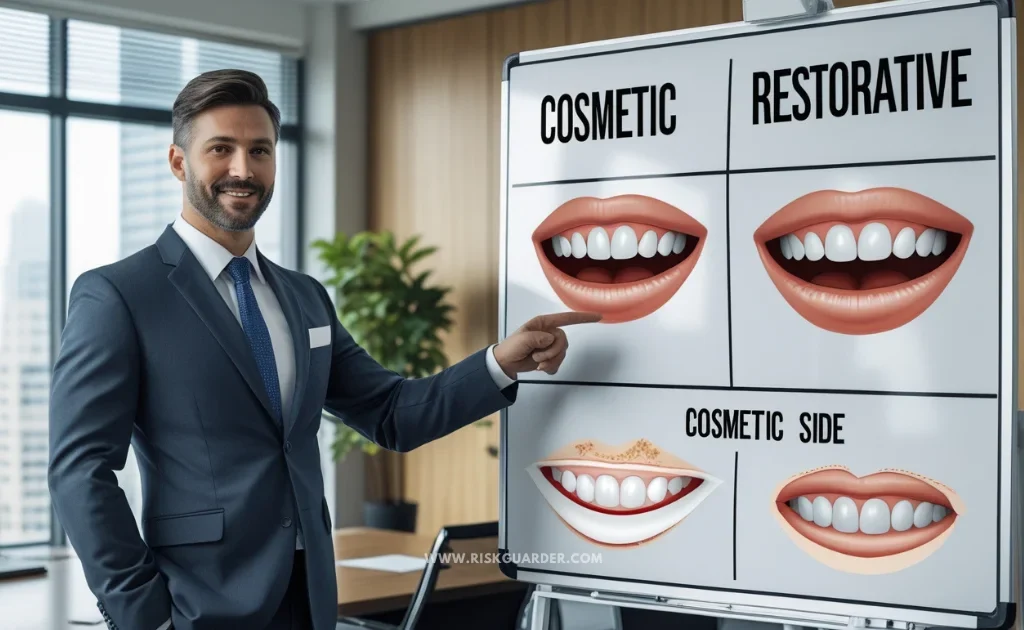You want that perfect smile with veneers, but the price tag is daunting. You’re wondering, “Can my insurance help?” The answer is complex, but this guide will give you the clear, honest breakdown. As insurance analysts at RiskGuarder, we’ve examined hundreds of dental policies and interviewed dental professionals to bring you the definitive answer on veneer coverage.
The Bottom Line Up Front
The Short Answer: In most cases, no. Standard dental insurance considers veneers a cosmetic procedure and excludes them from coverage.
The Critical Exception: Coverage is sometimes possible if the veneer is deemed medically necessary to restore a tooth’s function, such as after an accident or to replace a failing restoration.
The Key to Success: Getting coverage depends on your specific plan terms, your dentist’s clinical documentation, and successfully navigating the pre-authorization process.
This Guide Covers: We’ll explain the insurance rules, show you how to navigate the exceptions, reveal what you’ll actually pay, and outline all your alternative payment options.
Table of Contents
The Fundamental Rule: Why Insurers Say “No” (Cosmetic vs. Restorative)
Let’s get into why insurance companies usually give veneers the cold shoulder. It’s all about how they categorize dental work.

Cosmetic procedures are those that are all about looks—think teeth whitening and veneers. If your teeth are working fine for eating and talking, any enhancements are considered “nice to haves” rather than “need to haves.” As they say, “Most dental insurance plans won’t cover cosmetic procedures.”
On the flip side, we have restorative procedures. These are the ones that fix actual problems—like cavities, broken teeth, or gum disease. Insurers see these as medically necessary because they address health issues rather than just making you look good.
Here’s the kicker: veneers can actually fall into both categories. They can enhance your smile and also fix a damaged tooth. But proving to your insurance company that you need a veneer for health reasons? Yeah, that’s where it gets tricky.
Most dental insurance policies have clear exclusions for cosmetic procedures, so if you want coverage, you and your dentist need to make a solid case that the veneer is fixing something real, not just prettying up your smile.
The Exception: How to Make a Case for “Medical Necessity”
Okay, so you’ve got a chance to get coverage if you can show that your veneers serve a real purpose. Here are some scenarios where you might actually get lucky:
When Could a Veneer Be Covered?
- Accidents Happen: If you’ve chipped or broken a tooth from, say, a sports injury or a clumsy fall, a veneer could restore both the look and function of that tooth.
- Old Fillings Gone Bad: If you’ve got an old filling that’s failing and your dentist thinks a veneer is the best fix, you might be able to get coverage. They just need to prove it’s the best option.
- Congenital Issues: In some rare cases, if you have a tooth defect from birth, a veneer might be considered necessary. But those cases usually require a lot of documentation.
Your Dentist’s 3-Step Action Plan for Pre-Authorization
So, you want to get that veneer covered? Here’s how to do it:
Step 1: Clinical Documentation and Photography
Your dentist needs to create a detailed record showing why the veneer is necessary. This means they’ll take notes about your tooth, snap some high-quality photos of the damage, and maybe even take X-rays. They need to explain why cheaper options, like fillings, won’t cut it.
Step 2: The Narrative Letter
Next up, your dentist will write a letter to the insurance company explaining why the veneer is the best choice for your tooth. This letter needs to have some serious clinical jargon and reference the right dental codes. Basically, it should scream “medical necessity” to the insurance folks.
Step 3: Submitting the Pre-Authorization
Finally, all of this paperwork goes to your insurance company for review. This usually takes about 2-4 weeks. During this time, the insurance company’s dental consultants will look at your case and decide if they’ll cover it. Crossing your fingers is optional but recommended!
The Cost Breakdown: What You’ll Really Pay With & Without Insurance
Understanding the true financial impact of veneer treatment requires examining costs across different coverage scenarios. Our analysis reveals significant variations based on your insurance status and chosen payment method.

Estimated Cost of One Porcelain Veneer:
| Coverage Type | Your Out-of-Pocket Cost | Additional Considerations |
|---|---|---|
| Full Price (No Coverage) | $900 – $2,500 | Varies by geographic location and dentist experience |
| With Partial Insurance Coverage (50% of major restorative benefit) | $450 – $1,250 + deductible | Must meet annual deductible first; subject to annual maximums |
| With Dental Discount Plan (25% discount) | $675 – $1,875 | No deductibles or waiting periods; immediate savings |
Keep in mind that these costs are for a single veneer. Most people don’t just stop at one; a full smile makeover could require six to eight veneers, which can set you back anywhere from $5,400 to $20,000 without insurance. Even with partial coverage, you’re likely looking at $3,000 to $12,000 out of pocket.
Also, where you live plays a big role in pricing. If you’re in a big city like New York or L.A., expect to pay 20-40% more than if you were in a smaller town. Plus, cosmetic specialists can charge higher fees for their expertise, because, well, they’ve earned it.
When it comes to insurance, if you’re lucky enough to get coverage, it usually falls under major restorative benefits, where you pay 50% after meeting your deductible. But be warned—annual maximums usually cap at $1,000 to $2,000, which means your insurance will only help out so much.
Your Financial Toolkit: 5 Ways to Afford Veneers if Insurance Says No
If your insurance gives you the cold shoulder, don’t worry! There are still ways to make veneers more affordable. Here are some options to consider:

1. Dental Discount Plans
These plans are like a secret weapon for saving money on dental work. They’re not insurance, so they don’t have all the annoying rules about deductibles and waiting periods. You just pay an annual fee (usually between $100 and $200) and get discounts on dental procedures, including veneers. You can save anywhere from 10% to 25%!
The catch? You have to see dentists who are part of the plan. So, make sure to check if your favorite dentist is in the network before signing up.
2. Third-Party Financing (CareCredit and Alternatives)
Ever heard of CareCredit? It’s a popular financing option for medical and dental care. They offer promotional financing that can help you manage the cost of veneers. You might get a 0% interest period for 6 to 24 months, which can give you some breathing room.
This option is accepted by a ton of dental offices, so it’s pretty convenient. Just remember, the application process is quick, and you can often get approved on the spot.
There are also other financing companies like Lending Club and Prosper Healthcare Lending that offer similar services, just with different terms.
3. In-House Payment Plans
A lot of dental offices offer their own financing plans. This means you can negotiate payment terms directly with your dentist. It’s a more personal approach, and many offices are willing to work with you to create a plan that fits your budget.
These plans often have more lenient requirements than traditional financing options, making them accessible even if you don’t have perfect credit. You might be able to set up a monthly payment plan that spans 12-24 months with low or no interest.
4. Dental Schools
If you’re looking to save some serious cash, consider getting your veneers done at a dental school. Students perform the work under the supervision of experienced faculty, which means you can save 50-75% compared to private practice fees.
Just keep in mind that this route requires a bit more patience. Appointments might take longer, and you’ll likely have to go in for multiple visits. But hey, it’s a great way to help students learn while also saving money!
5. Using Your FSA or HSA
If you have a Flexible Spending Account (FSA) or a Health Savings Account (HSA), you can use pre-tax dollars to pay for qualifying dental expenses. This can include veneers if they’re deemed medically necessary. It’s like getting a tax break on your smile!
FSAs operate on a “use it or lose it” basis, so make sure to use those funds before the year ends. HSAs, on the other hand, are a bit more flexible since the funds don’t expire, and you can even invest them for future growth.
Coverage by Carrier: A Look at Major Insurance Plans
Let’s take a peek at how some of the big insurance players handle veneer coverage. Understanding their policies can help you set your expectations.
Does Delta Dental Cover Veneers?
Delta Dental, the largest dental insurance network in the U.S., generally follows the same rules as most insurers. They classify veneers as cosmetic procedures, so you might hit a wall when trying to get coverage. However, if the veneer is deemed medically necessary (like after an accident), you could get some help.
Their policy clearly states that “procedures performed primarily for cosmetic reasons” aren’t covered. Still, if your dentist provides solid documentation showing that the veneer is necessary to restore function or replace a failing restoration, you might have a shot at getting it covered.
Delta Dental’s claims review process involves dental consultants who assess the clinical necessity of proposed treatments. So, the better your documentation, the better your chances!
Does MetLife Cover Veneers?
MetLife’s approach is pretty similar to Delta Dental. They also classify veneers as cosmetic and typically won’t cover them unless they’re deemed medically necessary. They want clear documentation proving that the veneer isn’t just for looks.
The pre-authorization process usually involves submitting your clinical records and a detailed treatment plan for review. MetLife allows for online submissions, which can streamline the approval process. But be warned—getting approval can still be a bit of a challenge.
Frequently Asked Questions
Are veneers considered cosmetic or major restorative procedures?
Most insurance companies classify veneers as cosmetic, but they can be considered major restorative when used to fix damaged teeth or replace failing restorations. It all comes down to the specific circumstances and how well your dentist documents them.
What makes a veneer medically necessary?
Veneers are considered medically necessary when they restore function, protect damaged structures, or address congenital issues. Think repairing teeth damaged in an accident or replacing large fillings that have failed.
How long does the pre-authorization process take?
Usually, it takes about 2-4 weeks for insurance companies to process pre-authorization requests. If your case is more complex, it might take longer, so be sure to submit it well in advance of your planned treatment.
Can I appeal a denied veneer claim?
Absolutely! Most insurance companies have formal appeal processes. You’ll just need to provide additional documentation supporting the medical necessity of the treatment. But be prepared—success rates for appeals can be low without compelling evidence.
Do all dentists accept insurance for veneer treatment?
Not all dentists are in-network for every insurance plan, and some may only work on a fee-for-service basis. It’s wise to check if your dentist accepts your insurance and if they have experience with veneer pre-authorizations.
Final Thoughts: A Plan for Your Perfect Smile
Ugh, dealing with insurance for veneers? Yeah, it can feel like wrestling a bear sometimes – frustrating and kinda exhausting. But hey, it’s not hopeless! If your teeth actually need the help (like, it’s not just for looks), your dentist is your secret weapon. A good one who knows the insurance game can totally fight your corner and help you make your case. Seriously, having them in your corner is half the battle won.
Now, if your insurance flat-out says “Nope, cosmetic stuff ain’t covered!” (which, let’s be real, happens a lot), don’t throw in the towel just yet! There are actually tons of ways to make it work without winning the lottery. Think payment plans that don’t suck, dental discount clubs (like a membership for cheaper care), or even using those special health savings accounts (HSAs/FSAs) where you pay with pre-tax cash. Pretty sweet, right?
Look, getting veneers is about way more than just having a magazine-worthy smile (though that’s awesome too!). It’s about finally feeling confident flashing those pearly whites, you know? Feeling good in your own skin! So whether you’re battling insurance paperwork or figuring out payments, just remember: that boost to your grin and your mood? Totally worth the hassle. Go get that dazzling smile, my friend! You got this!






